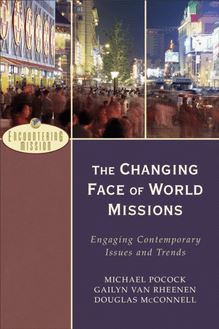Christianity Encountering World Religions (Encountering Mission) , livre ebook
271
pages
English
Ebooks
2009
Vous pourrez modifier la taille du texte de cet ouvrage
Obtenez un accès à la bibliothèque pour le consulter en ligne En savoir plus
Découvre YouScribe en t'inscrivant gratuitement
Découvre YouScribe en t'inscrivant gratuitement
271
pages
English
Ebooks
2009
Vous pourrez modifier la taille du texte de cet ouvrage
Obtenez un accès à la bibliothèque pour le consulter en ligne En savoir plus
Publié par
Date de parution
01 avril 2009
Nombre de lectures
0
EAN13
9781441205261
Langue
English
Poids de l'ouvrage
1 Mo
Publié par
Date de parution
01 avril 2009
Nombre de lectures
0
EAN13
9781441205261
Langue
English
Poids de l'ouvrage
1 Mo
A. Scott Moreau, series editor
Also in the series:
Introducing World Missions: A Biblical, Historical, and Practical Survey, Second Edition
A. Scott Moreau, Gary R. Corwin, and Gary B. McGee
The Changing Face of World Missions: Engaging Contemporary Issues and Trends
Michael Pocock, Gailyn Van Rheenen, and Douglas McConnell
Encountering Missionary Life and Work: Preparing for Intercultural Ministry
Tom Steffen and Lois McKinney Douglas
Encountering Theology of Mission
Craig Ott and Stephen J. Strauss, with Timothy C. Tennent
Developing a Strategy for Missions
John Mark Terry and J. D. Payne
Effective Intercultural Communication
A. Scott Moreau, Evvy Hay Campbell, and Susan Greener
© 2009 by Terry C. Muck and Frances S. Adeney
Published by Baker Academic a division of Baker Publishing Group P.O. Box 6287, Grand Rapids, MI 49516-6287 www.bakeracademic.com
Ebook edition created 2011
Ebook corrections 02.17.2015
All rights reserved. No part of this publication may be reproduced, stored in a retrieval system, or transmitted in any form or by any means—for example, electronic, photocopy, recording—without the prior written permission of the publisher. The only exception is brief quotations in printed reviews.
Library of Congress Cataloging-in-Publication Data is on file at the Library of Congress, Washington, D.C.
ISBN 978-1-4412-0526-1
Unless otherwise indicated, Scripture is taken from the Holy Bible, New International Version®. NIV®. Copyright © 1973, 1978, 1984 by Biblica, Inc.™ Used by permission of Zondervan. All rights reserved worldwide. www.zondervan.com
Scripture quotations labeled KJV are from the King James Version of the Bible.
Scripture quotations labeled NASB are from the New American Standard Bible®, copyright © 1960, 1962, 1963, 1968, 1971, 1972, 1973, 1975, 1977, 1995 by The Lockman Foundation. Used by permission. www.lockman.org
Scripture quotations labeled NRSV are from the New Revised Standard Version of the Bible, copyright © 1989, by the Division of Christian Education of the National Council of the Churches of Christ in the United States of America. Used by permission. All rights reserved.
Scripture quotations labeled TNIV are from the Holy Bible, Today’s New International Version®. TNIV®. Copyright © 2001, 2005 by Biblica, Inc.™ Used by permission of Zondervan. All rights reserved worldwide. www.zondervan.com
Contents Cover Series Page Title Page Copyright Page Introduction
Part 1 Context, Text, and Pre-texts 1 Context: The World of Religion Today 2 Text: What the Bible Says 3 Pre-texts: Theology and Personality
Part 2 Practices: Beyond Competition and Cooperation 4 Universality: Reaching Out to All, Including Christians 5 Fellowship: Belonging Precedes Believing 6 Localization: Focusing on Questions and Concerns of the Local Community 7 Commitment: Holding Ideas with Conviction; Acting Decisively on Those Ideas; Not Letting Those Ideas Be Divisive 8 Freedom: Honoring the Principle of Religious Choice 9 Effectiveness: Allowing the Context to Determine the Form of Witness 10 Consistency: Striving for Consistency between Methods and Goals 11 Variety: Communicating the Gospel in Many Forms 12 Respect: Not Disparaging Others in Order to Champion Your Own; Not Disparaging Your Own in Order to Respect Others 13 Charity: Loving Those to Whom We Witness 14 Missional Ecumenicity: Practicing Mission as the Joint Project of the Church 15 Jesus, Mission Innovator: Jesus’s Model of Giftive Mission
Part 3 Method: How Do We Do It? 16 The Spiral of Knowledge Acquisition: Learning about New Cultures and New Religions 17 Experiencing: The Influence of Our Personal Histories 18 Bracketing: Putting Convictions on Hold 19 Encountering: Learning from a New Culture and Religion 20 Evaluating: Appraising the New Culture and Religion from a Christian Viewpoint 21 Integrating: Reshaping Our Own Views and Mission Practices
Part 4 Giftive Mission 22 Metaphors for Mission 23 The Four Gifts 24 Giftive Mission
Appendix: Biblical Interreligious Encounters Bibliography Index
Introduction
W hat is the Christian responsibility to people who already believe in and belong to another religion? How should Christians witness to people who are Buddhist, or Hindu, or Muslim, or members of some other religion?
We believe that Christian responsibility begins with giving witness to what God has done through Jesus Christ to offer us the gift of salvation. We believe that “giftive mission” is the form that witness should take in the twenty-first century. This book is an explanation of and an argument for giftive mission. This approach is necessary because our culture at large gives radically different answers to the question of what the Christian responsibility to people of other religions is.
At one end of the spectrum of these answers is the “do nothing” response. According to this view, Christians should do nothing regarding the spiritual disposition of nonbelievers. If Christians have any responsibility to adherents of non-Christian religions, it begins and ends with concern for the simple requirements of human well-being: food, water, clothing, shelter, peace, and justice.
At the other end of the spectrum of answers is the “wipe them out” response. Christians should spare no energy in eradicating the non-Christian religions of the world. Non-Christian religions and the people who follow them are demonic. We are fully justified in using whatever means necessary to accomplish this goal, including political power and warfare.
Like most end-of-the-spectrum answers to such questions, there is little subtlety to either the “do nothing” or the “wipe them out” responses. Some mission organizations offer more subtle versions of these responses, and many if not most take positions well distanced from either extreme. We will explore many of these positions in this book. But what is surprising, even alarming, in today’s climate of tension among religions is that extreme, end-of-the-spectrum answers increasingly seem to be considered plausible by more and more people. Intellectually these positions may seem to be reductive stereotypes. Empirically, however, they are not. People believe them and act on them, to little positive effect and a growing list of negative effects.
We Christians desperately want to think we are still having a positive effect with traditional mission efforts. And it is not hard to produce evidence that seems to support that belief. Never before have more missionaries been sent to “foreign” fields: American missionaries, European missionaries, Korean missionaries, Indian missionaries. Tens of thousands of people convert to Christianity each year as a result of these efforts. Christianity is still the largest religion in the world, with almost two billion members.
But what do these numbers mean? Consider: never before have more Buddhist, Hindu, and Muslim “missionaries” been sent to “foreign” fields. Tens of thousands of people convert to Buddhism and Islam each year as a result of these efforts. Islam grew faster than Christianity in the twentieth century, and Buddhism has become a viable religion in both Europe and North America.
In fact, when Christian growth numbers are considered as a percentage of world population, for the last one hundred years the results of the Christian mission movement have remained stagnant. According to David Barrett and Todd Johnson in World Christian Trends , in the year 1900 Christians made up 34.5 percent of the world’s population; in the year 2000, Christians made up 33 percent of the world’s population (2001, 4).
And what do we do about these realities? We talk about the places Christianity is still growing and ignore those where it is either stagnant or in decline. We wax eloquent about growth that can’t be measured or confirmed house churches in China and background believers in the Muslim world and pretend we don’t notice the closing of national borders to Christian mission workers across the 10/40 window.
The growth of Christianity in the so-called southern world is indeed a wonderful story. But the status quo state of Christianity in the Middle East, North America, and Europe is a scandal. The lack of growth in Asia and South Asia is a nightmare. In those places where people have embraced an enduring world religion other than Christianity, we have had and are having little mission success.
Consider just one aspect of the nightmare: the Buddhist world. The Christian mission movement has failed in cultures with a dominant Buddhist element. Let’s generously define failure as at least a century of mission effort that has resulted in less than 25 percent of the people in such cultures coming to know Jesus Christ as their Lord and Savior.
No predominantly Buddhist culture has ever been a Christian mission success, that is, with more than 25 percent of the people in the culture embracing Christianity.
Korea has come the closest. The most recent figures for South Korea have between 25 and 30 percent of the population identifying themselves as Christian. But if you add North Korean figures, the figure falls below our failure threshold. Other Buddhist countries don’t even come close. Consider nine other Buddhist countries:
Country % Buddhists % Christians
Bhutan 78 1 Cambodia 86 1 Japan 55 3 Laos 43 3 Mongolia 23 1 Myanmar (Burma) 73 8 Sri Lanka 68 9 Thailand 83 2 Vietnam 49 9
Total the figures for these Buddhist countries, and you find that the Christian mission movement has resulted in an average of less than 5 percent of the population in these countries embracing Christianity, despite almost two centuries of mission efforts.
Lest we think that this is the norm for Christian mission efforts, compare it with the results from two other heavily missionized parts of the world, Oceania and Africa. The first Christian mission workers went to Africa in the seventeenth century, and by 1900, 10 million Africans knew Christ, that is, 10 percen








